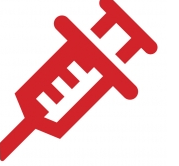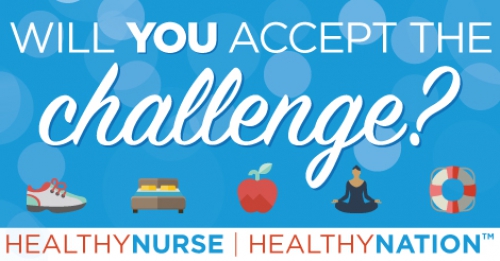Healthy Nurse, Healthy Nation™ Blog - Don’t Get Stuck: Learn How To Prevent Sharps Injuries
Published
ANA’s Senior Policy Advisor Ruth Francis, MPH, MCHES, shares strategies for keeping nurses safe from sharps.
When nurses care for others, they often wind up putting their own health at risk. In fact, nurses face myriad safety issues in the workplace. One of the most prevalent: Getting stuck with a needle or other sharp object (such as a scalpel, lancet, or syringe). According to the Centers for Disease Control and Prevention (CDC), an estimated 385,000 sharps-related injuries occur annually among health care workers in hospitals. And studies report that 40 percent of sharps injuries in hospitals happen to nurses, not doctors. Not only do cuts from sharp objects injure the nurse, they can also expose him or her to blood-borne diseases, such as HIV, Hepatitis B, or Hepatitis C.
Why are sharps and needlestick injuries so prevalent?
Most sharps or needlestick injuries occur in fast-paced environments, such as in the emergency room or during an operation. Sometimes nurses are accidentally jabbed with a needle by a surgeon or a fellow nurse. Other times, nurses stick themselves when they’re trying to retrieve a tool. “When you’re working on adrenaline or with quick impulses, that’s when incidents are more likely to occur,” says Ruth Francis, MPH, MCHES, and ANA’s Senior Policy Advisor.
What’s worse, careless errors can cause nurses or other hospital staff to get stuck with a needle or cut by a sharp object. For example, if a needle isn’t disposed of properly and is accidentally left on bed sheets or a towel, a nurse or member of the hospital housekeeping staff may pick up the bedding and be injured. Everyone makes mistakes, but when units are understaffed and nurses have to rush between patients, on-the-job injuries are more likely.
Always dispose of sharps in an appropriate sharps container. Furthermore, the CDC recommends carefully monitoring sharps containers to avoid overfilling.
Prevention is key
The Needlestick Safety and Prevention Act, which passed in 2000, revised the Occupational Safety and Health Administration (OSHA)’s blood-borne pathogens standard to include specific additional definitions and requirements for employers, including:
Since the bill passed, injuries in all healthcare settings have declined by 38 percent overall and sharps injuries specifically have also declined, reports Infection Control Today.
To prevent sharps and needlestick injuries, keep these tips in mind from Stanford Medical Center:
What to do if you get stuck
First and foremost, report the incident. “We don’t have an accurate take on what the true incidence rate is because injuries are not always reported,” says Francis. Often, nurses or hospital staff blame themselves or their colleagues for getting stuck with a needle. “For instance, a nurse doesn’t have a lot of say in whether or not a surgeon decides to use the newest, safest equipment, like retractable needles,” says Francis. Surgeons often prefer to use equipment they’re accustomed to. Unfortunately, injuries occur when staff use tools that aren’t as safe, particularly in the high-pressure setting of the OR. Nurses may be hesitant to report an incident, especially if it portrays the surgeon or another colleague in a bad light.
If you do suffer an injury, the CDC recommends the following:
For more tips, visit the ANA’s Sharps Injury Prevention webpage for other resources on needlestick and sharps safety.
What practices does your unit or hospital have in place to prevent sharps or needlestick injuries? Tell us in our discussion or in our private Facebook group. If you found this post helpful, please share it on Facebook, Twitter, and Instagram by clicking the icons to the left.
 Have you joined the Healthy Nurse, Healthy Nation (HNHN) Grand Challenge yet? Join us today!
Have you joined the Healthy Nurse, Healthy Nation (HNHN) Grand Challenge yet? Join us today!
Updated 12/5/22
Source List:
Stop sticks campaign. (2011, June 24). Retrieved September 11, 2017. (Editor's note: now available here as of 12/5/22).
Executive Summary: American Nurses Association Health Risk Appraisal (HRA). (2014, October). (Editor's note: this link is no longer available).
Using safer devices, following hierarchy of controls can cut sharps injuries. (2016, May 07). Retrieved September 11, 2017. (Editor's note: link updated 12/5/22).
E. (2016, June 29). Stanford sharps doodle. Retrieved September 11, 2017.
Why are sharps and needlestick injuries so prevalent?
Most sharps or needlestick injuries occur in fast-paced environments, such as in the emergency room or during an operation. Sometimes nurses are accidentally jabbed with a needle by a surgeon or a fellow nurse. Other times, nurses stick themselves when they’re trying to retrieve a tool. “When you’re working on adrenaline or with quick impulses, that’s when incidents are more likely to occur,” says Ruth Francis, MPH, MCHES, and ANA’s Senior Policy Advisor.
What’s worse, careless errors can cause nurses or other hospital staff to get stuck with a needle or cut by a sharp object. For example, if a needle isn’t disposed of properly and is accidentally left on bed sheets or a towel, a nurse or member of the hospital housekeeping staff may pick up the bedding and be injured. Everyone makes mistakes, but when units are understaffed and nurses have to rush between patients, on-the-job injuries are more likely.
Always dispose of sharps in an appropriate sharps container. Furthermore, the CDC recommends carefully monitoring sharps containers to avoid overfilling.
Prevention is key
The Needlestick Safety and Prevention Act, which passed in 2000, revised the Occupational Safety and Health Administration (OSHA)’s blood-borne pathogens standard to include specific additional definitions and requirements for employers, including:
- Updating exposure control plans
- Using safety-engineered devices (SEDs) whenever possible
- Keeping a sharps exposure log
Since the bill passed, injuries in all healthcare settings have declined by 38 percent overall and sharps injuries specifically have also declined, reports Infection Control Today.
To prevent sharps and needlestick injuries, keep these tips in mind from Stanford Medical Center:
- Wear double gloves, goggles, and a face shield when suturing or administering a needle.
- Use a needle only one time. Do not recap it. Activate the safety immediately after use.
- Opt for safe sharps, such as retractable needles, blunt suture needles, safety scalpels, or needleless blood transfer equipment, if available.
- Dispose of needles properly in a sharps-approved disposal container. Keep the container as close to work areas as possible.
- Do not leave sharps out where they may injure others.
- Use mechanical devices to pass sharps. Never pass them by hand.
- Communicate with your colleagues and use verbal alerts when passing sharps.
- Keep exposed sharps in view at all times and be aware of anyone around you.
- Participate in blood-borne pathogens training.
What to do if you get stuck
First and foremost, report the incident. “We don’t have an accurate take on what the true incidence rate is because injuries are not always reported,” says Francis. Often, nurses or hospital staff blame themselves or their colleagues for getting stuck with a needle. “For instance, a nurse doesn’t have a lot of say in whether or not a surgeon decides to use the newest, safest equipment, like retractable needles,” says Francis. Surgeons often prefer to use equipment they’re accustomed to. Unfortunately, injuries occur when staff use tools that aren’t as safe, particularly in the high-pressure setting of the OR. Nurses may be hesitant to report an incident, especially if it portrays the surgeon or another colleague in a bad light.
If you do suffer an injury, the CDC recommends the following:
- Wash the wound with soap and water; flush mucous membranes; and irrigate eyes with clean water, saline, or sterile irrigants depending on where on your body your injury occurred.
- Seek medical treatment for the injury immediately.
- Report the incident to your supervisor. ANA also recommends documenting the injury according to employer policy, including the type and brand of device causing injury, department where the injury occurred, and explanation of the incident.
For more tips, visit the ANA’s Sharps Injury Prevention webpage for other resources on needlestick and sharps safety.
What practices does your unit or hospital have in place to prevent sharps or needlestick injuries? Tell us in our discussion or in our private Facebook group. If you found this post helpful, please share it on Facebook, Twitter, and Instagram by clicking the icons to the left.
 Have you joined the Healthy Nurse, Healthy Nation (HNHN) Grand Challenge yet? Join us today!
Have you joined the Healthy Nurse, Healthy Nation (HNHN) Grand Challenge yet? Join us today!Updated 12/5/22
Source List:
Stop sticks campaign. (2011, June 24). Retrieved September 11, 2017. (Editor's note: now available here as of 12/5/22).
Executive Summary: American Nurses Association Health Risk Appraisal (HRA). (2014, October). (Editor's note: this link is no longer available).
Using safer devices, following hierarchy of controls can cut sharps injuries. (2016, May 07). Retrieved September 11, 2017. (Editor's note: link updated 12/5/22).
E. (2016, June 29). Stanford sharps doodle. Retrieved September 11, 2017.
Blog Safety
10/11/2017 7:05pm CDT



Post a Comment or Question